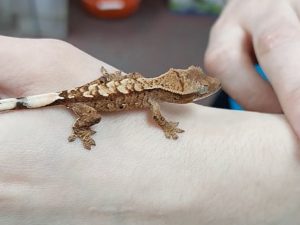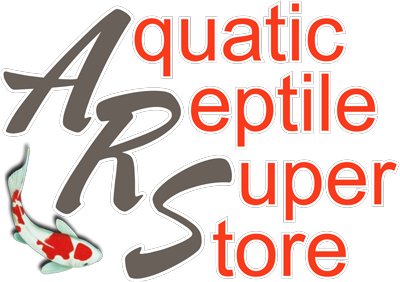Crested Gecko
Rhacodactylus ciliatus

Crested Geckos come from the various islands in the South Pacific that make up New Caledonia. They are known for their expressive faces, and the crest that runs along their body from head to tail. The spines above their eyes make them appear to have eyelashes, hence their alternate name – The Eyelash Gecko.
They were first discovered in 1866 by a French zoologist called Alphonse Guichenot, but were then thought to be extinct until their rediscovery in 1994.
Latin Name: Rhacodactylus ciliates
Difficulty Level: Beginner
Temperament: Docile
Life Span: 10 – 20 Years
Size: 7″ – 10″ ¦ 30g – 35g
Habitat: Arboreal – Warm Tropical Rainforests.
Diet: Balanced diet of both Fruit and Insects (Fruits can be given in the form of Gecko paste diets). Feed 3 – 4 times per week for Adults, and daily for Juveniles.
Insects include; Locusts and Crickets. (Give Waxworms as a treat).
The insects should be slightly smaller than the space between the Gecko’s eyes, and should be gut-loaded with veggies.
Avoid feeding them Mealworms or anything with a hard shell. This is undigestible for Crested Geckos.
Supplements: Calcium, if necessary. However this shouldn’t be needed if the Crested Gecko is fed a balanced diet. Vitamin D3.
Hours of Activity: Nocturnal – Crested Geckos are most active at night time.
Handling: Crested Geckos are easy to handle, and learn to enjoy spending time with their owners. They can drop their tails when spooked, so avoid touching their tails where possible.
Temperature:
20°C – 24°C Ambient day time temperature.
26°C – 28°C Basking temperature.
18°C – 24°C Night time temperature.
Humidity: 40% – 60% – Occasionally increase to 70%
Vivarium Size: 40cm x 40cm x 60cm (Minimum)
Tall vertical enclosures are best, as Crested Geckos are Arboreal and love to climb.
Substrate Type: Bark, Soil, Specialised Crested Gecko Substrate.
Equipment Necessary: Vivarium, Heat Lamp / Heat Mat, Thermostat, Misting System or Spray Bottle, UV lamp.
Cleaning Instructions: Spot clean any waste and uneaten food daily. Replace substrate entirely once per month.
Healthy Behaviour: Sleeping and Hiding during the day, Licking their eyeballs, Feeding well at night, coming out to hunt.
Sick Behaviour: Sudden weight loss, Darkened skin colour, Blood in their feces.
Like a lot of Lizards, Crested Geckos can drop their tail when frightened or as a defence mechanism against predators. The tail will eventually grow back but it will never be the same. It will differ in thickness, length, and even colour.
Crested Geckos can be kept in small groups with one Male to several Females. If you decide to keep several, make sure there is only one Male, or else they will fight.
Make sure there are plenty of branches and plants (or plastic plants) for them to climb, with plenty of hiding spots.
If you don’t have an automatic misting system, be sure to use a spray bottle to spray water into the enclosure every day to keep humidity levels adequate.
Common Problems:
Skin Conditions – Make sure the humidity levels are adequate or the Crested Gecko may have trouble shedding, and even get rashes.
Dehydration – Keep the humidity levels between 50% – 70% at all times, or the Crested Gecko will dehydrate and can die.
Respiratory Infections – If the humidity level is constantly too high, their respiratory systems can get infected. Seek veterinary advice.
Loss of Metabolism and Bodily Functions – This can occur if the temperature is too low. Make sure there is adequate heating at all times.
Stress – Crested Geckos get stressed if the temperature is too high. Look for signs, including not feeding, and darkening of the skin colour.
Stomatitis – Reddening around the mouth and excessive drooling. Seek veterinary advice ASAP.
